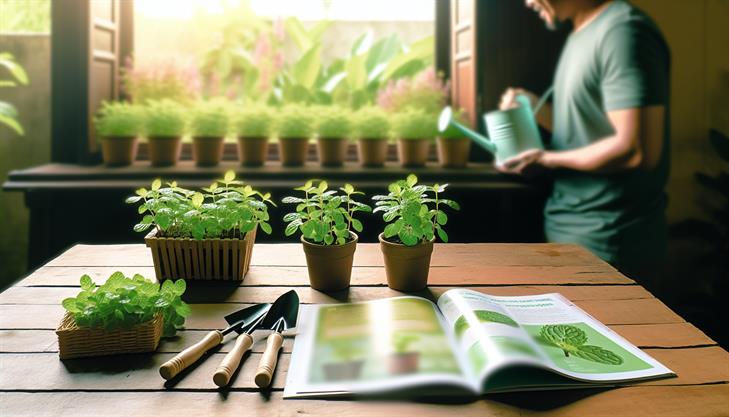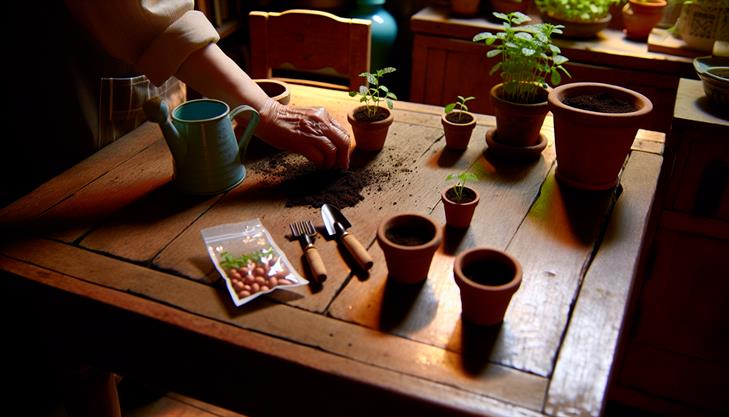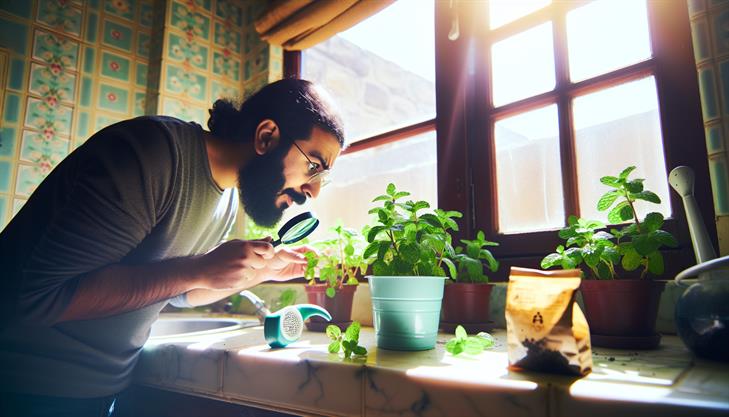Imagine stepping into your kitchen to snip a few fresh mint leaves, ready to invigorate your homemade mojito, enliven a sunny salad, or garnish a steaming cup of tea. Growing a mint plant indoors can transform this everyday fantasy into a fragrant reality. But mint is more than just a culinary delight—it’s a resilient herb known for its refreshing aroma and numerous health benefits. Yet, nurturing it indoors comes with its own unique set of challenges and rewards. Whether you live in a cramped apartment or a sprawling home, mastering the art of cultivating mint indoors ensures you have an endless supply of this versatile herb right at your fingertips. Dive into this comprehensive guide, where we’ll unveil tips, tricks, and techniques to cultivate a thriving mint plant, all while enhancing your home with a touch of verdant elegance. Your journey towards a greener, flavorful lifestyle starts here—grow alongside us!
Setting Up the Ideal Indoor Environment for Mint
Growing a mint plant indoors can be a rewarding endeavor, ensuring a steady supply of fresh leaves for your culinary or medicinal needs. Follow these step-by-step instructions to set up an ideal indoor environment for your mint plant, all while avoiding common issues and optimizing growth.
Choose the Right Variety and Container
Select a mint variety suitable for indoor growth, such as spearmint or peppermint. Begin with young plants or cuttings, which establish more quickly than seeds. Choose a container with good drainage—preferably a pot made of materials like clay or plastic—ensuring it has drainage holes to prevent waterlogging.
Ideal Lighting Conditions
Mint thrives in abundant light. Place your mint plant in a location that receives at least 6-8 hours of indirect sunlight daily. If natural light is insufficient, consider using a grow light to supplement. Position the light about 12-14 inches above the plant to mimic sunlight adequately.
Temperature and Humidity
Maintain indoor temperatures between 65-70°F (18-21°C) for optimal growth. Mint plants prefer moderate humidity, so if your home is particularly dry, consider placing a tray of water near the plant or misting it occasionally to maintain moisture levels.
Soil and Watering Requirements
Use nutrient-rich, well-draining potting soil. A blend with added perlite or vermiculite is ideal, as it prevents compaction and enhances airflow. Water your mint plant when the top inch of soil feels dry. Mint prefers consistently moist soil, but overwatering can lead to root rot. It’s best to water thoroughly until excess water drains out of the bottom of the pot.
Nutrient and Fertilization Needs
Feed your mint plant with a balanced, all-purpose liquid fertilizer every 4-6 weeks during its growing season, typically spring through early fall. Avoid over-fertilization, as it can affect the flavor and quality of the mint leaves.
Pruning and Maintenance
Regularly prune your mint plant to encourage bushier growth and prevent it from becoming leggy. Pinch off the tips of the stems and remove any flowers that may appear; this focuses the plant’s energy on producing leaves. Also, check for any yellowing leaves or pests, such as aphids, and address issues promptly.
Common Issues and Troubleshooting
Watch for signs of stress, such as wilting leaves or discoloration. These may indicate issues like overwatering, inadequate light, or pest infestations. Adjust care routines based on these signs to maintain your plant’s health. If pests are identified, gently wash the leaves with a soapy water solution or use an organic insecticidal spray.
Additional Tips for Success
Rotate your plant every few days to ensure even light distribution and use an oscillating fan to mimic outdoor breezes, which can strengthen the plant’s stems and improve air circulation.
By following these guidelines, you’ll successfully grow a mint plant indoors, providing you with fresh and aromatic leaves throughout the year. With the right care and attention, your indoor mint plant can flourish, becoming a healthy and productive addition to your home garden.
Step-by-Step Guide to Planting Mint Indoors
Mint is an incredibly versatile herb that is perfect for growing indoors, offering fresh leaves for culinary uses and a pleasant aroma for your home. By following this step-by-step guide, you’ll learn how to grow a mint plant indoors effectively.
Step 1: Choosing the Right Variety
Start by selecting a mint variety that suits your needs. Popular choices include peppermint, spearmint, and chocolate mint. Each offers unique flavors, so consider what you plan to use the mint for before deciding.
Step 2: Selecting an Appropriate Container
Mint prefers a well-draining environment. Choose a pot with drainage holes to prevent waterlogging, which can lead to root rot. A 10-12 inch container is ideal for a single plant, allowing ample room for growth.
Step 3: Preparing the Soil
Use a high-quality potting mix that retains moisture yet drains well. You can enhance the soil mix by adding a bit of sand or perlite. Avoid garden soil, as it might compact too much indoors, hindering growth.
Step 4: Planting the Mint
You can start your mint plant from seeds, seedlings, or cuttings. If using seeds, gently press them into the soil and cover with a light layer of soil. For seedlings or cuttings, plant them about one inch deep. Ensure the roots are well-covered and the plant is stable.
Step 5: Providing Adequate Light
Mint requires bright, indirect light to thrive. Position your plant near a sunny window where it can receive 4-6 hours of sunlight daily. If natural light is limited, consider using a grow light to supplement.
Step 6: Watering Properly
Mint prefers consistently moist soil, but avoid overwatering. Check soil moisture by sticking a finger about an inch into the soil; if it feels dry, it’s time to water. Ensure excess water drains to prevent root rot.
Step 7: Maintaining Humidity
Indoor environments can be dry, especially in winter. Increase humidity around your mint plant by misting regularly or placing a small humidifier nearby. Alternatively, setting the pot on a tray of water and pebbles can help maintain adequate moisture levels.
Step 8: Fertilization
Feed your mint plant with a balanced, all-purpose fertilizer every 4-6 weeks to promote vigorous growth. Avoid over-fertilizing, as this can lead to excessive leaf growth with reduced flavor intensity.
Step 9: Pruning and Harvesting
Regularly trim your mint to encourage bushy growth. Harvest leaves as needed by pinching off the stems above a leaf pair. Frequent pruning will help your plant remain compact and full.
Common Issues and Solutions
- Leggy Growth: If your mint becomes leggy, it might be due to insufficient light. Increase light exposure or adjust your grow light setup.
- Pests: Aphids and spider mites are occasional problems. Gently wash leaves with a mixture of water and mild dish soap to deter them.
- Yellowing Leaves: This can indicate overwatering or nutrient deficiency. Adjust your watering schedule and ensure your plant receives the necessary nutrients.
By adhering to these steps, you can successfully grow a mint plant indoors, ensuring a fresh supply of this delightful herb year-round. Enjoy using your homegrown mint in teas, desserts, or as a fragrant addition to any room.
Essential Care Tips for Thriving Mint Plants
Growing mint plants indoors can be a rewarding and aromatic experience, especially given the ease with which these plants adapt to indoor environments. Here’s a comprehensive guide to help you successfully grow mint plants indoors, ensuring they thrive and provide fresh leaves for your culinary and medicinal needs.
Step 1: Choosing the Right Mint Variety
To start, select the type of mint you want to grow. Spearmint and peppermint are among the most popular indoor varieties due to their adaptable nature and culinary versatility. Once you’ve chosen, source your mint plant from a nursery or start from cuttings.
Step 2: Selecting the Appropriate Container
Mint plants require sufficient room to grow, so choose a container at least 8-10 inches deep with proper drainage holes to prevent waterlogging. A pot with drainage is essential to avoid root rot, a common issue with overwatered mint plants.
Step 3: Potting Mix and Planting
Fill the container with a well-draining potting mix. A general-purpose soil mixed with some perlite or sand works well. If you’re using a mint cutting, ensure that it’s buried to cover at least one node, allowing roots to establish more quickly. For potted mint, gently loosen the roots and transplant it into your container.
Step 4: Light Conditions
Mint thrives in bright, indirect sunlight. Place your plant near an east or west-facing window where it can receive adequate light without being scorched by direct sun. If natural light is insufficient, particularly in winter months, you might consider a grow light to supplement the light requirements.
Step 5: Watering Schedule
Maintaining the right moisture level is crucial when learning how to grow mint plants indoors. Mint prefers consistently moist soil but not soggy. Water your mint plant when the top inch of soil feels dry. Ensure excess water can drain freely to prevent root rot.
Step 6: Temperature and Humidity
Mint plants favor a mild indoor temperature between 65 to 70°F (18 to 21°C). They also thrive in humid conditions; if your home is dry, occasionally mist the leaves or place a small humidifier nearby.
Step 7: Fertilization
Feed your indoor mint plant a balanced liquid fertilizer every 4-6 weeks during the growing season (spring and summer). Over-fertilizing can produce leggy plants with less flavor, so use it sparingly.
Step 8: Pruning and Harvesting
Regular pruning encourages bushier growth and prevents mint from becoming leggy. Trim back regularly, snipping stems just above a node. Harvesting frequently will stimulate new growth and keep your mint healthy.
Common Issues and Solutions
- Spider Mites and Aphids: These pests can be controlled with insecticidal soap or by rinsing the leaves with water.
- Yellow Leaves: This could indicate overwatering. Check your drainage and adjust your watering practices.
- Legginess: Insufficient light often causes mint to grow tall and spindly. Ensure your plant gets enough light or consider moving it closer to a window or placing it under a grow light.
By following these steps and tips, you’ll learn not only how to grow mint indoors successfully but also how to enjoy the endless benefits of having fresh mint at your fingertips. This aromatic herb can transform your meals, teas, and even the ambiance of your home with its refreshing scent.
Troubleshooting Common Mint Growth Problems
Growing mint indoors can be a highly rewarding endeavor, offering fresh leaves for culinary and medicinal uses year-round. To cultivate a thriving indoor mint plant, follow these straightforward steps and troubleshoot common problems to keep your plant healthy and vibrant.
Choosing the Right Container
Start by selecting a container with adequate drainage holes to prevent waterlogging, a common issue that can lead to root rot. A pot that is at least 8-12 inches wide is ideal, as mint tends to spread rapidly. Opt for a clay or plastic pot depending on your preference, but ensure the container allows excess water to drain away.
Selecting the Soil
Use a high-quality potting mix that retains moisture without becoming waterlogged. Ideally, the soil should be slightly acidic to neutral in pH, around 6.0 to 7.0. Consider adding a bit of perlite or sand to improve drainage, which is crucial for healthy root development.
Planting the Mint
You can start with seeds, cuttings, or small nursery plants. If using seeds, plant them about ¼ inch deep and lightly cover them with soil. For cuttings, ensure they have a root length of at least 2-3 inches before planting. Space multiple plants at least 12 inches apart if sharing a container to provide adequate room for growth.
Providing Light
Mint plants thrive in indirect sunlight. Place your container near a south-facing window to receive at least 4-6 hours of indirect light a day. If natural sunlight is insufficient, supplement with fluorescent or LED grow lights, keeping the lights about 12 inches above the plant.
Watering
Maintain consistent soil moisture by watering when the top inch of soil feels dry. Avoid overwatering, which can cause root rot, a prevalent issue with indoor plants. Ensure excess water can escape the pot through drainage holes.
Fertilizing
Mint requires minimal feeding. Use a balanced, water-soluble fertilizer every 4-6 weeks during the growing season. Be cautious with the application to prevent salt buildup, which can negatively impact growth.
Common Issues and Solutions
Pest Problems: Indoor mint plants can attract pests like aphids and spider mites. Combat them using a mild insecticidal soap or neem oil spray, ensuring to cover both the top and bottom of leaves.
Leggy Growth: Insufficient light can result in leggy mint plants. Move the plant to a brighter location or increase the duration of grow light exposure.
Yellowing Leaves: Overwatering is the usual culprit. Check drainage and reduce watering frequency if necessary. Also, ensure the plant isn’t sitting in water.
Weak Flavor: Light and nutrition deficiencies can weaken mint flavor. Ensure your plant receives enough light and the occasional feeding of balanced fertilizer, but avoid over-fertilizing.
Additional Tips
- Rotate your mint plant periodically to ensure even light exposure, preventing lopsided growth.
- Regularly pick mint leaves to promote new growth, but avoid pruning more than one-third of the plant at a time.
- If your indoor space becomes too dry, increasing humidity can benefit your mint plant. Use a humidifier or place a tray of water nearby to boost humidity levels.
By following these steps and addressing any issues promptly, you can successfully grow a mint plant indoors, ready to enhance your culinary creations with fresh flavor anytime.
Tools and Accessories for Successful Mint Cultivation Indoors
Growing a mint plant indoors is a rewarding endeavor that offers fresh herbs throughout the year. Whether you are a gardening novice or an experienced green thumb, cultivating mint inside your home can be straightforward and fulfilling. Here’s a detailed guide to ensure your mint plant thrives:
Choosing the Right Mint Variety
First, decide which type of mint you want to grow. Popular varieties include spearmint and peppermint. Each has a unique aroma and flavor profile, so select the one that best suits your culinary needs.
Selecting a Suitable Container
Mint plants prefer roomy containers with good drainage. A pot that’s at least 8-10 inches wide is ideal to allow the spreading roots the space they need. Ensure the container has multiple drainage holes to prevent waterlogging.
Soil Preparation
Use quality potting soil enriched with organic matter for optimal growth. Mint thrives in well-drained, nutrient-rich soil. Adding some perlite or sand can further improve drainage and prevent the roots from becoming waterlogged.
Planting the Mint
-
Cuttings or Seedlings: Purchase mint cuttings or seedlings from a reputable nursery. You can also propagate mint by taking a healthy cutting and placing it in water until roots develop.
-
Planting Process: If using cuttings, plant them in soil once roots are visible. For seedlings, gently loosen the roots and place them into your prepared pot. Cover with soil and lightly pat down.
Positioning and Light Requirements
Place your mint plant in a spot that receives plenty of indirect sunlight, ideally receiving 5-6 hours per day. A windowsill is often perfect, but avoid harsh, direct sunlight which can scorch the leaves. If natural light is insufficient, consider using a grow light.
Watering and Humidity
Mint prefers consistently moist soil but overwatering can lead to root rot. Check the soil moisture regularly with your finger; it should feel slightly damp but not soggy. Mist the leaves occasionally to maintain the humidity levels mint loves.
Pruning and Harvesting
Regular pruning promotes bushier growth. Start harvesting leaves once the plant is well-established, usually about 4-6 inches tall. Pinch off the leaves or cut just above a set of leaves to encourage new growth. Regular harvesting will keep your plant healthy and productive.
Common Issues and Solutions
- Pests: Monitor for pests such as aphids or spider mites. Insecticidal soap can effectively manage infestations.
- Leaf Yellowing: Often indicates overwatering. Allow the soil to dry out slightly before the next watering.
- Leggy Growth: This can be due to insufficient light. Move your plant to a brighter location or supplement with additional lighting.
Additional Tips for Success
- Rotate your plant periodically to ensure even light exposure.
- Fertilize monthly during the growing season with a balanced, water-soluble fertilizer to support healthy growth.
- Avoid placing your mint near heat sources or air conditioners, which can disrupt the plant’s preferred temperature and humidity conditions.
By following these guidelines on how to grow a mint plant indoors, you’ll enjoy an abundant supply of fresh mint leaves for your teas, cocktails, and dishes. Patience and attention to your mint’s needs will surely result in a thriving indoor herb garden.
In conclusion, growing a mint plant indoors is a rewarding endeavor that can provide you with fresh, flavorful herbs right at your fingertips. By selecting the right variety of mint and ensuring it has ample sunlight or artificial light, you can cultivate a healthy and thriving plant. Remember the importance of well-draining soil, consistent watering without over-saturating, and regular pruning to encourage bushier growth. Pest management through natural remedies can help maintain your plant’s health, while repotting when necessary ensures continuous growth.
Now that you’re equipped with these essential tips and tricks, it’s time to apply what you’ve learned and enjoy the aromatic benefits of fresh mint in your home. Whether you’re using it for culinary purposes, medicinal uses, or simply to enhance the vitality of your space, a mint plant is sure to enrich your indoor garden.
As a final tip, try to occasionally rotate your plant to ensure even growth and consider experimenting with different mint varieties, such as peppermint or chocolate mint, once you feel confident in your indoor gardening skills. Happy planting!


